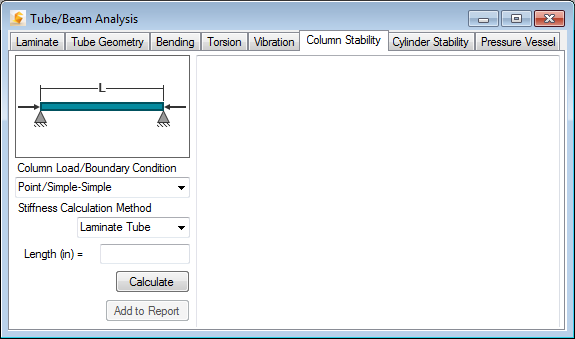Perform a column stability analysis on a composite tube or beam.
To begin the column stability analysis, navigate to the Column Stability tab in the Tube/Beam Analysis window as shown below. The basis of the calculations performed for this option is Euler column buckling for long columns, as defined in the Aerospace Design Engineers Guide (Ref. 11.5).

- Column Load/Boundary Condition - The analysis load type is selected from a drop-down menu. A pictorial depiction of the selected load type is displayed. The dimensions and loading required to define the analysis is depicted in the drawing.
There are two basic load types available (Point and Distributed). There are four boundary condition types available (Simple-Simple, Fixed-Fixed, Fixed-Simple, and Fixed-Free) that have two load types each for a total of eight possible load/boundary condition types.
- Stiffness Calculation Method - Of particular interest on this form are the "Stiffness Calculation Method" options. These options apply to closed cross-sections only (rectangle, circle, and ellipse). The "Ply-By-Ply Tube" option forces all bending analyses to be calculated on a ply-by-ply basis through the thickness of the laminate. That is, the stiffness contribution for each ply is modeled separately. The "Laminate Tube" option uses the structural (or smeared) properties of the entire laminate in bending calculations. Whenever you analyze a closed section beam using the "Laminate Tube" option, turn the "Coupling" option under the Laminate tab to zero. This is critical to generating accurate results.
- Length - Specify the overall length of the column.
- Calculate - Once the input has been completed, click Calculate to compute the column stability analysis. The output box on the right side of the window shows the results of the defined analysis. For columns which have a cross-section with different area moments of inertia about different axes, the lowest "I" value is used in the calculation.
Results displayed include:
- Critical Load - (units of force) The compressive load on the column at which the column will buckle. The equation below shows the Critical Load Euler equation, where "P" is the Euler buckling load, "C" is a constant, "EI" is the beam bending stiffness, and "L" is the beam length.

The equation below shows the Euler equation for columns under distributed loads, where "p" is a uniformly distributed load over a lower portion of the column length and "a" is the length in which the distributed load is acting over from the bottom of the column.

- Critical Stress - (units of force per length squared) The compressive stress on the column at which the column will buckle. The equation below shows the Critical Stress equation, where "σ" is the critical stress, "C" is a constant, "Ex" is the Young's modulus of the composite, "L" is the beam length, and ρ is the radius of gyration of the beam cross-section.

- Critical Load - (units of force) The compressive load on the column at which the column will buckle. The equation below shows the Critical Load Euler equation, where "P" is the Euler buckling load, "C" is a constant, "EI" is the beam bending stiffness, and "L" is the beam length.